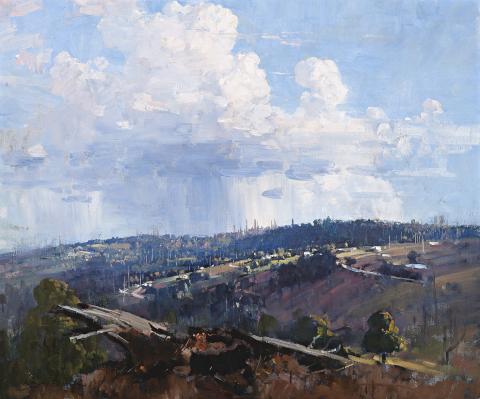SASSAFRAS, 1926
ARTHUR STREETON
oil on canvas
62.0 x 74.0 cm
signed lower left: A STREETON
bears inscription verso: 275 / RMC / R. M. Clark esq
The Macquarie Galleries, Sydney
Sir Reginald Marcus Clark, Sydney
The Estate of the Late Sir Reginald Marcus Clark, K.B.E., James R. Lawson, Sydney, 10 – 14 June 1954, lot 34 (as ‘Sassafras, Victoria’)
Private collection, New South Wales
Thence by descent
Private collection, New South Wales
Exhibition of Oil Paintings by Arthur Streeton, The Macquarie Galleries, Sydney, 10 – 26 March 1927, cat. 3
Loan Exhibition of Works by Arthur Streeton, National Art Gallery of New South Wales, 1931, lent by Mr Marcus Clark
Streeton Memorial Exhibition, The National Art Gallery of New South Wales, Sydney, 12 April – 20 May 1945, cat. 42, (as ‘Sassafras, Victoria’, lent by Sir Reginald Marcus Clark)
Streeton, A., The Arthur Streeton Catalogue, Melbourne, 1935, cat. 880, p. 136, 30” x 25”, in the possession of Mr Marcus Clark
When Sassafras, 1926 was shown in Arthur Streeton’s exhibition at The Macquarie Galleries, Sydney, the art critic for The Sydney Morning Herald hailed the show as being ‘representative of his best style – mellow toned, strongly realistic, and skillfully composed.’1 Of the many landscapes, he wrote, ‘Almost without exception, they are bathed in that brilliant, warm light which is so characteristic of Australia, as compared with the broken and colder glow that usually rests on landscapes in England.’ The chief painting in the exhibition was ‘City of laughing loveliness, Sun-girdled Queen’ 1921, a captivating view of Sydney Harbour. Sassafras appealed so greatly to (later Sir) Marcus Clark, then one of Australia’s leading art collectors, that he added it to his already substantial holding of Streeton’s paintings. Clark had an outstanding collection of Australian and British art representing the proverbial ‘who’s who’ of the time … Tom Roberts, Frederick McCubbin, Rupert Bunny, George Lambert, Elioth Gruner, Julius Olsson R.A., Sir John Lavery R.A., A. J. Munnings A.R.A. and many others. His Roberts was the stunning Holiday Sketch at Coogee, 1888 (now in the collection of the Art Gallery of New South Wales), with an equally vibrant work by Bunny, The Green Caterpillar. His collection aroused such interest that, after a Sydney showing in 1923, it toured Tasmania from June to September of 1926, being exhibited in Hobart at the Tasmanian Museum and Art Gallery, and at Launceston. Five Streetons were in the Tasmanian exhibition, and years later Venice – The Doges’ Palace; Chelsea Reach; Vancouver; Battersea Bridge; Boys Bathing of 1889; Gindecca [sic] Lagoon; and Sassafras were included in the Streeton Memorial Exhibition held at the National Gallery of New South Wales in 1945.
Painted in the same richly productive year as Land of the Golden Fleece (private collection), Sassafras provides an engaging lyrical setting for a theme that was to occupy the artist in his later years – his deep concern for the future of the Dandenong Ranges and their majestic gum trees. Into the grandeur of the panoramic scene of Sassafras with its majestic and overarching sky of blue and clouds of plenty, Streeton introduces that wanton destruction seen in the vertical reach of dead trees and fallen timbers among the living. He symbolized the deforestation in the striking image of the remains of a once noble gum, slain in the foreground like some sacrificial victim. Its poignancy is heightened by the natural beauty of the scene and its bravura translation into paint. Streeton had moved to his new home ‘Longacres’ at Olinda in the Dandenongs in 1924. Here he continued to paint pictures of panoramic beauty and abundance. The year before he painted Sassafras, he gave an address to the Forest League titled ‘Australian Trees and Art’. He questioned why ‘should we suffer hundreds and hundreds of acres of valuable timber to be destroyed to facilitate some work of the moment when so little is gained for it?’ 2 The theme continued in such masterly works as Last of the Messmates, 1928 of the Dandenong Ranges, and The Vanishing Forest of Olinda (both private collections) of 1934.
1. ‘Oil Paintings. Mr. Streeton’s Exhibition’, Sydney Morning Herald, 10 March 1927, p. 6
2. Argus, Melbourne, 27 November 1925, p. 23, quoted in Mary Eagle, The Oil Paintings of Arthur Streeton in the National Gallery of Australia, Canberra, 1994, p. 164
DAVID THOMAS
